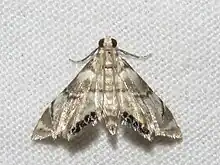| Eoparargyractis plevie | |
|---|---|
 | |
| Scientific classification | |
| Domain: | Eukaryota |
| Kingdom: | Animalia |
| Phylum: | Arthropoda |
| Class: | Insecta |
| Order: | Lepidoptera |
| Family: | Crambidae |
| Genus: | Eoparargyractis |
| Species: | E. plevie |
| Binomial name | |
| Eoparargyractis plevie (Dyar, 1917) | |
| Synonyms | |
| |
Eoparargyractis plevie is a moth in the family Crambidae. It was described by Harrison Gray Dyar Jr. in 1917.[1] It is found in North America, where it has been recorded from Florida, Maine, Massachusetts, New Hampshire, New York, Nova Scotia, Quebec and South Carolina.[2]
Adults have been recorded on wing from April to October.
The larvae are aquatic and have been recorded feeding on Lobelia dortmanna, Isoetes tuckermani and Isoetes muricata. They have a yellow head. Full-grown larvae reach a length of 11 mm. The larvae have been recorded from August to mid-November. The species overwinters in the larval stage. Pupation takes place in a cocoon, which is spun on a leaf at the base of the rosette.[3]
References
- ↑ "GlobIZ search". Global Information System on Pyraloidea. Retrieved 2014-07-15.
- ↑ Moth Photographers Group at Mississippi State University
- ↑ Fiance, S. B. & R. E. Moeller 1977. Immature stages and ecological observations of Eoparargyractis plevie (Pyralidae: Nymphulinae). Journal of the Lepidopterists' Society. Vol. 32 No. 2. p. 81.
This article is issued from Wikipedia. The text is licensed under Creative Commons - Attribution - Sharealike. Additional terms may apply for the media files.